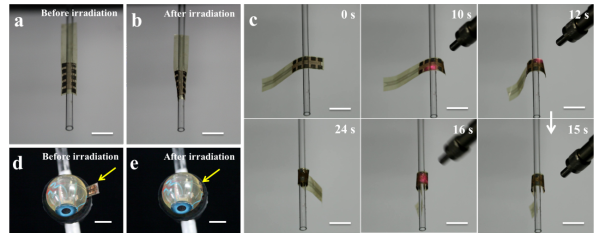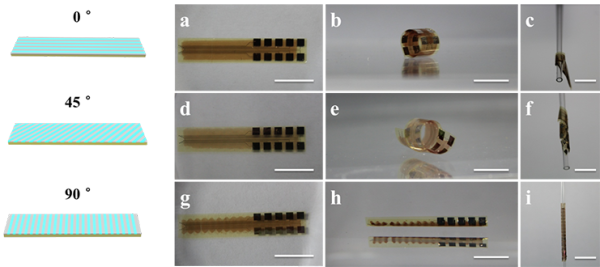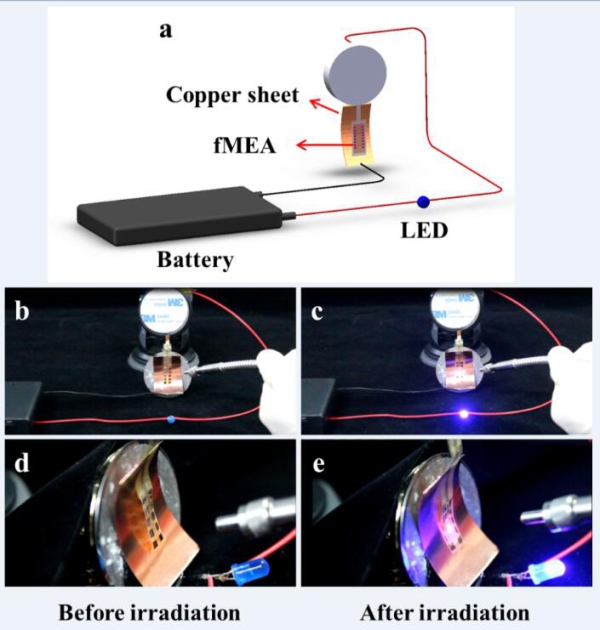Researchers Developed A Strategy for Preparing Shape-adaptable 3D Flexible Electronics
Date:01-11-2017 | 【Print】 【close】
Over the past few decades, flexible electronics offers compelling solutions for neural recording and stimulation devices and therefore have contributed extensively to medical applications, such as deep brain stimulators, heart pacemakers and retinal prosthesis and have been successfully applied in medical and life science fields such as neurological rehabilitation and brain science. All these features make flexible electronics a powerful research and treatment tool. Not only can flexible electronics monitor in-vivo biological signals, but they can also deepen and broaden the research of biological systems. Nevertheless, effective contact between flexible electronics and soft biological tissues, which may have different surface curvatures for medical applications, has long been a challenge.
Prof. DU Xuemin and his colleagues, from Shenzhen Institutes of Advanced Technology, Chinese Academy of Science developed a strategy for preparing shape-adaptable 3D flexible electronics by combining photothermally responsive poly (N-isopropylacrylamide)/gold nanorods (PNIPAM@AuNRs) composite hydrogels with conventional flexible microelectrode arrays (fMEAs).
The fMEAs-functionalized composite hydrogels are shape-adaptable and can accommodate different surface geometries. Triggered remotely in seconds by near-infrared (NIR) light at a wavelength of 808 nm, the composite hydrogel layer grafted on the back side of the fMEAs shrinks to induce a desirable shape transformation in the fMEAs. By patterning the responsive hydrogel layer, the fMEAs can exhibit planar-to-twisted structural transformations in response to an external stimulus as a result of differential shrinkage and their elastic moduli. This strategy not only enables fMEAs to modify their shapes to remotely accommodate unpredictable shapes of different surfaces by irradiation with NIR but also provides multiple architectures of 3D fMEAs upon stimulation. These photothermally responsive composite-hydrogel-based fMEAs may provide new methods for achieving wearable and implantable devices and facilitate deeper investigations into biological systems.
The paper titled “Photothermally triggered shape-adaptable 3D flexible electronics” was published in the Advanced Materials Technologies on August 15, 2017. This work is supported by the National Natural Science Foundation, Guangdong Innovative and Entrepreneurial Research Team Program and Shenzhen Peacock Plan.

Figure 1. Conforming behavior of the PNIPAM@AuNRs hydrogel-based fMEA before and after irradiation with NIR light (808 nm, 5 W) in air at room temperature. (Image by Prof. DU Xuemin)

Figure 2. Self-twisted 3D fMEAs produced by designing the PNIPAM@AuNRs composite hydrogel layer with periodic stripes of different crosslinking densities along the parallel gel stripes, passing at oblique angles of 0°, 45° and 90°. (Image by Prof. DU Xuemin)

Figure 3. Verification of the electrical continuity and functionality of the PNIPAM@AuNRs composite hydrogel-based fMEA. (Image by Prof. DU Xuemin)
Prof. DU Xuemin, Ph.D Principal Investigator
Shenzhen Institutes of Advanced Technology, Chinese Academy of Sciences
Shenzhen, Guangdong 518055, China
Tel:00-86-755-86582652
E-mail:xm.du@siat.ac.cn